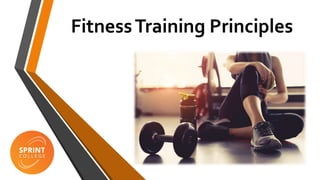
FIT Principles for Achieving Fitness Goals
- 2. In preparing your exercise programme, you need to bear in mind the following: • The individual and their requirements & goals. • Specific components of fitness required to be improved for the client to achieve their goals.
- 3. The individual and their requirements First you must establish the purpose of the exercise programme. There are many reasons why an individual may wish to undertake a personal exercise programme: to lose weight, to gain cardiovascular fitness for health or competition, returning from injury, muscle gain and so on. The client’s exercise goal will influence the design and the intensity of the work out programme.
- 4. Workout programs, and/or goals can be categorized into two main groupings 1: General health, well being and/or body fat loss (ie weight loss) 2: Sports specific performance activity including muscle growth
- 5. FITT Principles All exercise programs are based on F.I.T.T. Principle to keep the body challenged and to avoid monotony. When you exercise with adequate intensity, time and frequency of the body will adapt to the stress placed on it and will show desirable changes. F: Frequency is the number of times you exercise each week. I: Intensity is how hard you are working while you are exercising. (The effort you put forth.) T: Time is the total amount of time that is spent exercising in one session. T: Type is the type of exercise you are doing, cardio(aerobic) or resistance training(anaerobic).
- 6. Components of Fitness An exercise programme will need to address a the components of fitness, identified as relevant to achieve a clients goals. Select no more than four or five components to be part of any one exercise session.
- 7. Health Related Components of Fitness • Cardiovascular Endurance • Muscular Endurance • Strength • Flexibility Sports Specific Components of Fitness • Agility • Power • Balance • Co-ordination • Speed of Reaction • Timing Components of Fitness
- 8. Health Related Components of Fitness Cardiovascular Endurance Ability of heart and lungs to delivery oxygen to the working muscles Muscular Endurance Ability of the muscles to sustain near maximum effort over a prolonged duration. Strength The maximum force a muscle can generate once Flexibility The range of motion(ROM) a joint has.
- 9. Sports Specific Components of Fitness • Agility Agility or nimbleness is the ability to change the body's position efficiently • Power Refers to an individual's ability to exert a maximum amount of force in the shortest possible time • Balance Is the ability to stay upright or stay in control of body movement • Co-ordination The ability to use different parts of the body together smoothly and efficiently • Speed of Reaction The ability to respond quickly to a stimulus. • Timing The ability to coincide movements in relation to external factors
- 10. Principles ofTraining For steady progress and to avoid injury, fitness professionals should follow the principles of training (S.P.O.R.T) Specificity Progression Overload Reversibility Tedium
- 11. Every type of exercise has a particular effect on the body.The type of training we choose must be right for the type of improvement / result the client wants to see. We must always use a training programme that puts regular stress on the muscle groups or body systems that we want to develop, adapt & improve. We must train the correct component(s) of fitness that will give the client the required result they desire Specificity
- 12. The body takes time to adapt to more frequent or harder exercise. We must build up stress (effort) on our bodies in a gradual, or progressive way. As he body adapts to the exercise stress, the fitness professional must progress the clients program by changing some or all of the FITT principles. If you progress the clients program to quickly or by to much you increase the risk of injury or they may become disinterested with the program and give up. Progression
- 13. We can only achieve improvements in most aspects of physical performance by forcing the body to work just beyond it’s current known limits. In other words we overload it. Example – to improve our aerobic fitness by running, we could run more times a week, complete the run in a shorter time or increase the distance we run. Each one of these will overload the aerobic system. The aerobic system will gradually adapt to cope with the overload and we will become fitter. Overload
- 14. Reversibility The process of reversibility applies to most aspects of physical performance and fitness. It means that the effects (or improvements) of training will be lost at about one third of the rate at which they were gained. We lose our aerobic fitness more easily than our anaerobic fitness(strength), because our muscles quickly lose much of their ability to use oxygen.
- 15. Tedium(physical & mental boredom) Training programs must be varied to avoid tedium / boredom. By using a variety of different training methods, we will keep our clients enthusiasm and motivation. We can follow a long workout with a short one, a hard session with a relaxed one or a high speed session with a slow one. We could change the way we train and where we train.Variation, while still targeting the required components of fitness, will ensure a client stays motivated.